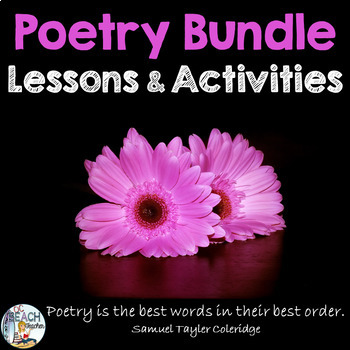Poetry Reading and Writing Activity Bundle
- Zip
Products in this Bundle (7)
showing 1-5 of 7 products
Description
This poetry bundle includes a variety of reading, writing, and review activities for your next poetry unit. These lessons inspire students with various poetic forms, authors, and creative activities and can be used during National Poetry Month or any time during the year. Lessons include the following and come packaged in a ZIP-file:
What is Poetry? In this lesson, students use inquiry to describe and define poetry. They begin by researching favorite poems. Then they read, analyze, and reflect on their poem choices. Next they work in groups to describe and define poetry. After a mini-lesson on metaphor, they then write a definition using figurative language for poetry in the form of a metaphor and share their ideas in whole–class discussion.
Shape Poems In this lesson, students first read examples of shape poems (also called concrete poems) and then write their own shape poems. After a “puzzling” warm up (using links to Rebus puzzles online), they read and analyze sample shape poems. Then they brainstorm simple shapes they can draw. In the next activity, they write words and phrases they associate with the shape. Finally, they use the pre-writing activities to draft their own shape poems, which they continue to take through the writing process.
Haiku Poems To begin, students read and analyze haiku poems. Additionally, they track images, symbols, and motifs in a prose selection such as a novel or short story. They use their examples to then write a haiku that captures a central idea or theme in the text. Finally, they use the haiku to write a literary analysis essay as they defend their word choices in the poem. If desired, the essay can be taken through the writing process.
Imagist Poems In this lesson, students read Imagist poems by William Carlos Williams. In pre-reading activities they read biographical information to build background. Next, they brainstorm for their own writing and use apples to practice understanding the literal and symbolic meanings of poetry. Then, they read Williams’ poems and answer questions to check for understanding. Finally, they use their pre-writing and reading to inspire the writing of their own poems.
Dialogue Poems In this lesson, students first read examples of dialogue poems (hyperlinks are provided to these poems, which are also called "poems for two voices") and then write their own dialogue poems. They start by brainstorming a list of characters that they could use in their poems, and then they journal about the perspectives of each of their chosen characters.
They continue going through the writing process, and finally, draft their own dialogue poems. Students use the six traits (ideas, organization, voice, word choice, sentence fluency, and conventions) for the peer revision, and the rubric evaluates their use of these traits.
Poetry Pictures Let your students show their creativity and use this activity to visualize a line of poetry. Inspired by Poets.org Free Verse Project, this lesson and activity engages students in reading, analyzing, and then imagining poetry. First, students view featured images of poetry lines from Poets.org and Flickr.com. Then, in Part 1, students search for favorite poems and explain their poetry choices in writing. In Part 2, students use their own creative techniques to produce images of their favorite lines of poetry. Next, they write a short literary analysis essay explaining how their image expresses the meaning of the selected poem.
Poetry Terms Trashketball Review Game This game assesses student knowledge of poetic terms in the context of lines from classic poems. Figurative language terms included are metaphor, simile, allusion, personification, and hyperbole. Sound devices included are alliteration, caesura, couplet, onomatopoeia, and iambic pentameter. Poets referenced include Samuel Taylor Coleridge, Carl Sandburg, Matthew Arnold, William Butler Yeats, W.H. Auden, Langston Hughes, Emily Dickinson, Gwendolyn Brooks, Elizabeth Bishop, Rita Dove, and others.
This 97-page bundle would be great for meeting the needs of diverse learners.
If preferred, find each lesson available separately at the links below:
Dialogue Poems Inspired Writing!
Imagist Poems - Inspired Writing
Poetry Terms Trashketball Review Game
Meaningful and Memorable English Language Arts by © OCBeachTeacher
All rights reserved by author.
Limited to use by purchaser only.
Group licenses available.
Not for public display.





